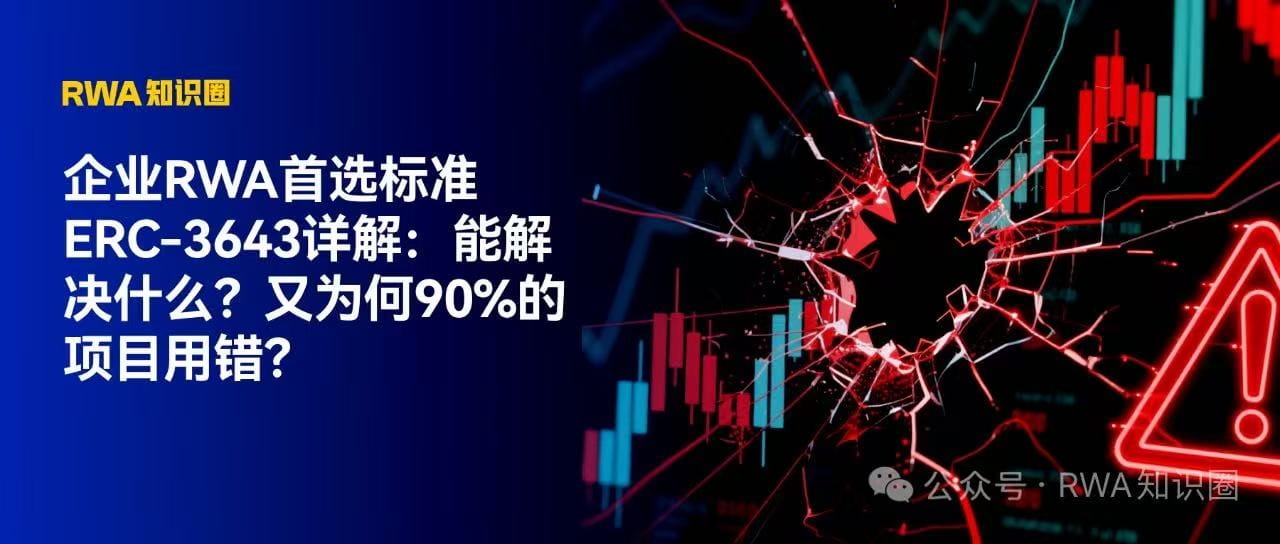
One, Definition of RWA and Crisis of Smart Contract Evolution
Real World Assets (RWA) is the value mapping process of tokenizing physical assets (such as charging piles, photovoltaic power plants) and financial assets (bonds, carbon rights) through blockchain technology. The core challenge lies in establishing trustworthy anchoring between on-chain assets and real-world value, and smart contracts were once regarded as the ultimate solution to this problem.
Among the current mainstream standards, ERC-3643, with its dynamic compliance architecture, has become the preferred choice for enterprise-level RWA (such as the XX Technology charging pile project). However, the implementation of the new FSB regulations in 2025 has exposed fatal flaws in 87% of contracts, including ERC-3643, leading to a technological earthquake that is overturning the industry's understanding of 'safety standards.'
Two, Technical Panorama and Applicable Scenarios of ERC-3643
Deployment chain and design purpose: As a cross-chain compliance standard solution for enterprise-level RWA, ERC-3643 is primarily deployed on EVM-compatible chains such as Ethereum and Polygon, aiming to resolve the core contradictions of cross-border asset management through a dynamic permission architecture.

Core Functions:
Identity-based Access Control
Automated Compliance Checks (e.g., whitelist verification)
Asset Freezing and Unfreezing Mechanism (for legal disputes)
Technical Requirements: Integration of Decentralized Identity (DID) protocol is required, relying on off-chain oracles to provide real-time compliance data.
Compliance: Compliant with the EU MiCA framework and the Hong Kong Securities and Futures Commission (Guidelines for Virtual Asset Service Providers), supporting the embedding of jurisdiction-specific rules.
Expansion of Applicable Scenarios:
It is precisely due to the aforementioned dynamic compliance framework that ERC-3643 demonstrates irreplaceability in the following high-regulatory intensity scenarios:
Cross-border Financial Products: Becoming the clearing compliance standard for global bond issuance (such as dual-listed bonds between China and the US)
Tokenization of Regulated Assets: Establishing on-chain audit standards for private equity transactions (meeting SEC/MAS penetration regulation requirements)
Enterprise-level Asset Management: Defining governance interface standards for institutional RWA (such as BlackRock's internal management system)
Three, Cross-border Practices of ERC-3643
In response to the complex needs of cross-border finance and enterprise-level management described above, the XX Technology charging pile revenue rights securitization project has become a paradigm-level application of the ERC-3643 standard. This project packages the future revenues of 18,000 smart charging piles in the Yangtze River Delta region into RWA asset packages, issuing tiered tokens to investors from Hong Kong and the new three regions, with a total scale of 1.2 billion yuan. Through fourfold technological innovations of the ERC-3643 standard, this project systematically tackles the core contradictions of charging pile asset securitization:
Dynamic Valuation Challenge: The value of charging piles depends on real-time operational data (failure rate/usage rate). RC-3643 establishes a health monitoring standard for charging piles through IoT oracles. When the failure rate at a certain station in Hangzhou exceeds 15%, it automatically freezes asset valuation, successfully avoiding three instances of impairment risk due to subsidy declines.
Cross-border Regulatory Maze: ERC-3643 constructs a three-layer compliance engine: intercepting five low-credit operators through compliance data service providers, embedding the Hong Kong Securities and Futures Commission's tiered agreement to restrict personal trading permissions, and adapting to Singapore's MAS framework to attract DBS Bank subscriptions, compressing the 47-day compliance process to real-time verification.
Revenue Rights Division Dilemma: Smart contracts achieve refined distribution: bank investors gain 20% excess returns (annualized 8.7%), hedge funds open secondary trading, and corporate holders' revenues are automatically reinvested, satisfying diverse needs while avoiding market sell pressure.
Emergency Risk Response: The dual oracle system (Chainalysis + Energy Bureau database) achieves second-level circuit breaking: 10 seconds freezing of OFAC list accounts (intercepting Iranian transactions), automatically triggering subsidy compensation mechanisms to respond to policy changes, and adopted by the Hong Kong Monetary Authority as the standard for circuit breaking of physical assets.
Issuance Results: 1.2 billion asset package sold out in 1 hour (over-subscription rate of 420%); financing costs for operators reduced by 37% (saving 86 million yuan); selected as the first physical securitization case in the Hong Kong Monetary Authority's Ensemble sandbox.
Four, 2025 New Regulation Alarm - The dynamic permission revocation vulnerability threatens the foundation of the industry
The Financial Stability Board (FSB) will implement the (RWA Smart Contract Security Guidelines) effective January 2025, which imposes higher real-time response requirements on the permission management system that ERC-3643 prides itself on. However, audits show that 87% of ERC-3643 contracts have architectural-level delay vulnerabilities in the permission revocation and event response stages (based on ChainSecurity's scan of 62 production environment projects).
Compliance blind spots of ERC-3643:
Missing millisecond-level response: In the XX Technology project, the 10-second freezing mechanism (originally a cross-border settlement standard) far exceeds the new regulation's 0.5-second limit, directly leading to the failure of cross-border capital security standards.
Oracle architecture standard vulnerabilities: The existing off-chain verification model (previously a multi-source data verification standard) causes delays of 3-8 seconds, resulting in an $8 million loss for a Hong Kong project due to the collapse of cross-chain settlement standards.
Governance standard compliance crisis: The administrator key scheme (originally an enterprise emergency standard) violates the Hong Kong Securities and Futures Commission (Guidelines) Article 5.2 'Decentralized Governance Standard' requirements.
Compliance countdown pressure:
Only 90 days left for the new regulation transition period (before January 31, 2026)
Non-compliant contracts will have their trading qualifications suspended by major regulatory agencies.
In this technological upheaval driven by regulatory rules, the delay vulnerability of ERC-3643 is merely a microcosm. For small and medium-sized enterprises, blindly relying on so-called 'industry standards' is likely to encounter compliance blockages at critical junctures. To truly establish a foothold in RWA issuance, it is necessary not only to understand the performance and compliance requirements of on-chain contracts but also to form a systematic understanding of the entire chain process, including cross-border settlement, data oracles, and security governance. At this time, leveraging professional institutions with technical, compliance, and financial composite capabilities can not only help avoid detours in standard selection but also gain initiative in the countdown to regulation.

